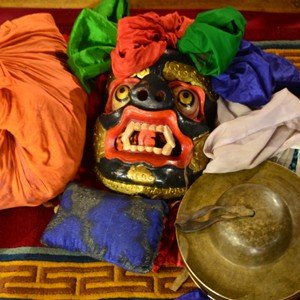
Dur Dag Skeleton mask
The practice of mask making amongst the Monpas can be traced to the influence of the Tibetan culture on the Local culture. Influenced by the totem worship of primitive Bonism, Tibetans started to express themselves by wearing animal masks.Masks can be classified into religious type and folk type in terms of their functions:
Religious masks are generally used in religious dance festivals, but they vary in different monasteries. This type usually includes three dimensional or semi-three-dimensional hard-shaped masks made from roughcasts. They are regarded as a form of sculpture. As Buddhist believers think that religious masks symbolize Gods and Spirits, they especially emphasize solemnity and constancy in the making of masks. This strict standard has resulted in the artistic form of religious masks becoming fixed. Religious masks are only used in performances held once a year but at other times they are hung and enshrined in monasteries, with the masks of a protective deity in the central position. Some masks in some particular monasteries have even become their treasures.
Folk art masks have diversified forms and are used in folk singing and dancing performances, operas as well as storytelling and ballad singing activities. These sort of masks emphasize the entertainment function and their production is therefore free from any design restrictions.
Masks can be classified into three types, in terms of subject:
Demon masks: mainly in form of a nine-headed demon, mountain god, sea god, dragon god and demons
Animal masks: mainly in the form of yaks, horses, rabbits, snakes, monkeys, lions, tigers, wolves, dogs, leopards, elephants, hawks, deer and foxes.
Human figure masks: mainly in form of witches, spell chanters, hermits, female demons, herdsmen, long-lived old men, etc.
During performances, masks are mainly used to express the characters’ happiness, anger, grief and joy and also demonstrate the true, the good, the beautiful and the ugly. The color of a particular Mask is quite significant and is it’s own meaning:
- Yellow masks represent profound knowledge and far-sightedness.
- Red masks represent bravery, intelligence, and the ability to use strategy to conquer or advise others.
- Green masks represent merit, virtue, achievements intelligence and kindness.
- Black and white masks represent saying yes and meaning no, or being changeable and unreliable.Black masks also represent ferociousness and cruelty while White Masks represent peace and auspiciousness.
- Purple masks represent jealousy and hatred.
- Blue masks represent fearlessness and heroism
One can visit the Craft Centre in Tawang to see the process of Mask Making and can also buy them there or in the local market.

Mask Making in Tawang

Mask Making in Tawang

Mask Making in Tawang

